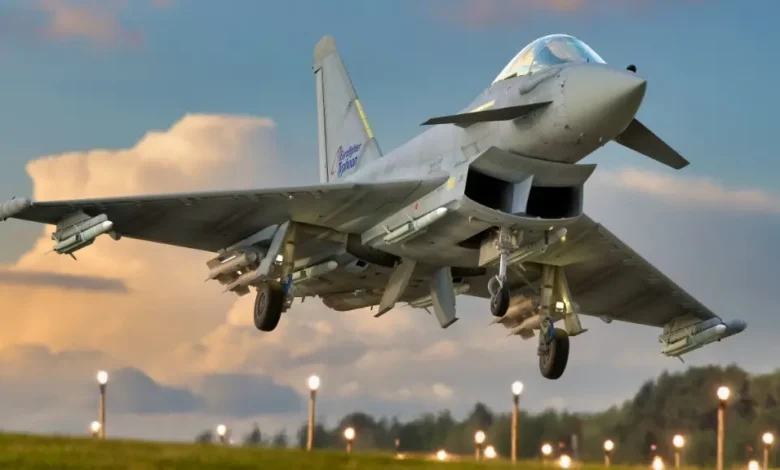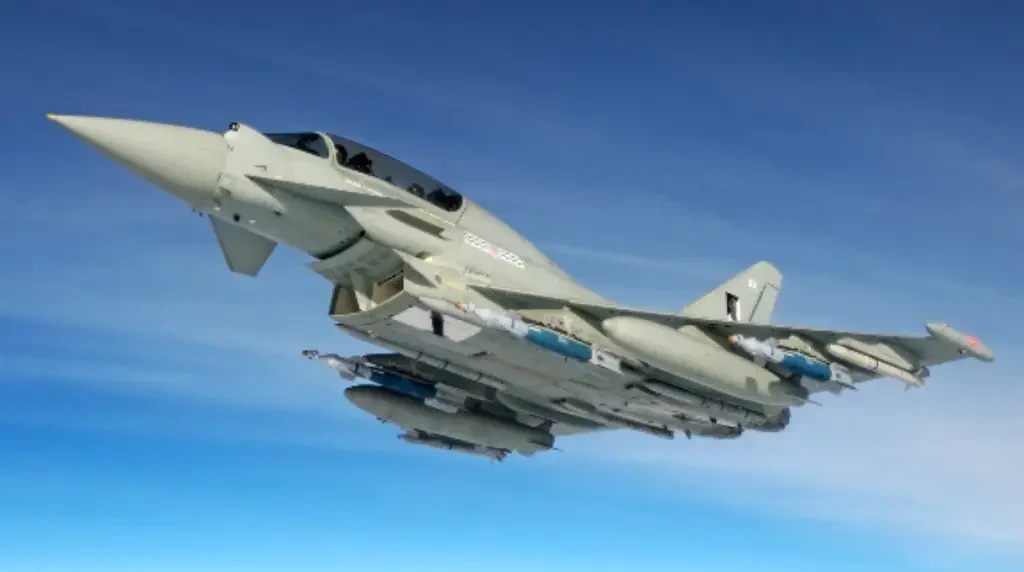Eurofighter Typhoon

The Eurofighter Typhoon is a twin-engine, multirole fighter aircraft developed by a consortium of European aerospace manufacturers, including Airbus, BAE Systems, and Leonardo. First flown in 1994 and introduced in 2003, the Typhoon is designed for air superiority, ground attack, and reconnaissance missions. Known for its agility, advanced avionics, and high performance, the Typhoon is operated by several European and international air forces.
Fact Sheet
| Role | Multirole fighter |
|---|---|
| Manufacturer | Eurofighter GmbH (Airbus, BAE Systems, Leonardo) |
| First Flight | 1994 |
| Service Entry | 2003 |
| Crew | 1 (Typhoon) or 2 (Trainer variant) |
Specifications
| Length | 15.96 m (52 ft 4 in) |
|---|---|
| Wingspan | 10.95 m (35 ft 11 in) |
| Height | 5.28 m (17 ft 4 in) |
| Empty Weight | 11,000 kg (24,250 lb) |
| Max Takeoff Weight | 23,500 kg (51,810 lb) |
| Powerplant | 2 × Eurojet EJ200 afterburning turbofans |
| Thrust | 20,250 lbf (90 kN) per engine with afterburner |
| Max Speed | Mach 2.0 (2,495 km/h; 1,550 mph) |
| Service Ceiling | 19,812 m (65,000 ft) |
| Range | 1,800 mi (2,900 km) combat radius |
| Rate of Climb | ~62,000 ft/min (315 m/s) |
Avionics & Armament
| Main Radar | Captor-E AESA radar |
|---|---|
| Avionics | Advanced avionics suite, electronic warfare systems |
| Armament | One 27-mm Mauser BK-27 cannon (150 rounds); Up to 13 external hardpoints for: – Air-to-air missiles (Meteor, AIM-120 AMRAAM, IRIS-T) – Air-to-ground munitions (Storm Shadow, Brimstone, Paveway IV) – Precision-guided bombs – External fuel tanks |
Notable Features
- Supermaneuverability with advanced flight control systems.
- Multirole capability for air-to-air and air-to-ground missions.
- Advanced avionics for superior situational awareness.
- High interoperability with NATO forces.
- Continuously upgraded with new variants and systems.

The Eurofighter Typhoon is a highly advanced, twin-engine, canard-delta wing, multirole fighter aircraft, representing a pinnacle of European aerospace engineering. It was designed and manufactured by Eurofighter GmbH, a consortium comprising Airbus (Germany and Spain), BAE Systems (United Kingdom), and Leonardo (Italy).
Development and Purpose
The origins of the Eurofighter Typhoon trace back to the early 1980s with the Future European Fighter Aircraft (FEFA) program. The aim was to develop a new fighter to meet the requirements of several European air forces, replacing older aircraft like the Panavia Tornado and SEPECAT Jaguar. While France initially participated, disagreements over design requirements led them to pursue their own project, the Dassault Rafale. The remaining nations – the UK, Germany, Italy, and Spain – formally established the Eurofighter consortium in 1986.
The first prototype made its maiden flight on March 27, 1994, and the aircraft was officially named “Typhoon” in September 1998. The first production aircraft was delivered in 2003, and it entered operational service shortly thereafter.
The Typhoon was originally conceived primarily as an air superiority fighter, optimized for air-to-air combat. However, throughout its development and various “Tranche” upgrades, it has evolved into a highly capable swing-role combat aircraft, meaning it can seamlessly switch between air-to-air and air-to-surface missions, even within the same sortie.
Key Design Features and Capabilities
- Canard-Delta Wing Configuration: This distinctive aerodynamic layout provides exceptional agility, high angle-of-attack capability, and efficient supersonic performance. The deliberately unstable airframe is managed by a sophisticated quadruplex digital fly-by-wire (FBW) system, which gives the pilot precise control and reduces workload.
- Twin Engines: Powered by two Eurojet EJ200 turbofan engines, each delivering around 90 kN (20,250 lbf) of thrust with afterburner. These powerful engines, combined with the aircraft’s relatively low weight, provide an excellent thrust-to-weight ratio, allowing for rapid acceleration, high climb rates, and supercruise capability (sustained supersonic flight without using afterburners).
- Advanced Materials and Design: The airframe extensively uses advanced composite materials (carbon fiber composites, glass fiber composites) and light metal alloys (aluminum-lithium, titanium). This contributes to a lighter, stronger airframe, and also aids in reducing the radar cross-section (RCS), giving it some degree of inherent stealth, though it’s not a true stealth fighter like the F-22 or F-35.
- “Glass Cockpit” and Human-Machine Interface: The cockpit features multiple large, reconfigurable multi-function displays (MFDs), a wide-angle Head-Up Display (HUD), and a Helmet-Mounted Display (HMD). It employs a Hands-On-Throttle-And-Stick (HOTAS) control concept, enhanced by Direct Voice Input (DVI), allowing the pilot to control critical functions without removing hands from the controls or looking down.
- Sophisticated Sensor Suite:
- CAPTOR-M/E Radar: The primary sensor is the CAPTOR-M mechanically scanned radar for earlier Tranches, and increasingly the CAPTOR-E Active Electronically Scanned Array (AESA) radar for newer production and upgraded aircraft. The CAPTOR-E provides a wider field of regard and superior performance in air-to-air and air-to-surface modes.
- PIRATE IRST: The Passive Infra-Red Airborne Tracking Equipment (PIRATE) is an advanced Infrared Search and Track (IRST) system, providing passive detection and tracking of targets, crucial for stealthy engagements.
- Praetorian DASS: The Defensive Aids Sub System (DASS) provides comprehensive protection against threats. It integrates Electronic Support Measures (ESM), Electronic Counter Measures (ECM) pods, Missile Approach Warners (MAW), Radar Warning Receivers (RWR), and chaff/flare dispensers, offering an all-round prioritized assessment of threats and automatic countermeasures.
- Diverse Armament: The Typhoon can carry a wide array of weapons on its 13 hardpoints (8 underwing, 5 fuselage).
- Air-to-Air Missiles: ASRAAM (short-range IIR), AIM-120 AMRAAM (medium-range active radar-guided), and the game-changing MBDA Meteor (long-range active radar-guided), which has a ramjet engine for sustained high speed and a very large no-escape zone.
- Air-to-Surface Weapons: Paveway IV (GPS/laser-guided bombs), GBU-48 Enhanced Paveway II, Storm Shadow (long-range cruise missile), Brimstone (precision anti-armor missile), and the Marte ER (anti-ship missile).
- Internal Cannon: A single 27mm Mauser BK-27 revolver cannon.
- Targeting Pods: Such as the Litening V.
Production “Tranches” and Upgrades
The Eurofighter program is structured in production “Tranches” (batches), each with incremental capability enhancements:
- Tranche 1: Initial production aircraft, primarily focused on air-to-air capabilities. Many have since been upgraded.
- Tranche 2: Improved multirole capabilities, enhanced avionics, and structural changes.
- Tranche 3A: Further enhancements, including provisions for conformal fuel tanks and more advanced sensors and weapons.
- Tranche 4 (Quadriga/Halcón): The latest production standard, featuring the CAPTOR-E AESA radar (ECRS Mk0/Mk1), advanced electronic warfare systems, and full integration of the latest weapons like Meteor and Storm Shadow. Germany’s “Quadriga” order and Spain’s “Halcón I & II” fall into this category.
- ECRS Mk2 Radar: The UK is leading the development of the highly advanced ECRS Mk2 AESA radar, which will provide even greater capabilities, including dedicated electronic attack functions.
Operators
The Eurofighter Typhoon is currently in service with or on order by:
- Germany (Luftwaffe)
- Italy (Aeronautica Militare)
- Spain (Ejército del Aire y del Espacio) – Spain is a partner nation and operates a significant fleet, with further orders for Tranche 4+ (Halcón II) to replace older F/A-18s.
- United Kingdom (Royal Air Force – RAF)
- Austria
- Saudi Arabia
- Oman
- Kuwait
- Qatar
Potential new customers include Turkey, Poland, and Portugal.
Combat History
The Eurofighter Typhoon has seen active combat in several operations:
- Libya (Operation Ellamy/Unified Protector, 2011): This was the Typhoon’s combat debut. UK RAF and Italian Air Force Typhoons primarily conducted reconnaissance and ground-strike missions, utilizing Paveway IV bombs and performing precision attacks.
- Iraq and Syria (Operation Shader, 2015-Present): RAF Typhoons have been continuously deployed as part of the coalition against ISIS, conducting extensive ground-attack missions with Paveway IV bombs, Brimstone missiles, and Storm Shadow cruise missiles, as well as providing air superiority.
- Air Policing Missions: Typhoons are the primary aircraft for Quick Reaction Alert (QRA) duties for their respective air forces, regularly intercepting and monitoring unidentified aircraft (often Russian military aircraft) approaching NATO airspace over the Baltic, Black Sea, and UK.
- Yemen (2015-Present): Saudi Arabian Typhoons have been actively involved in combat operations over Yemen as part of the Saudi-led intervention.
The Eurofighter Typhoon is a testament to multinational cooperation in advanced aerospace. Its continuous development and upgrade path ensure it remains a formidable and relevant combat aircraft, capable of performing a full spectrum of air operations well into the 2060s, and serving as a bridge to future sixth-generation combat air systems.



